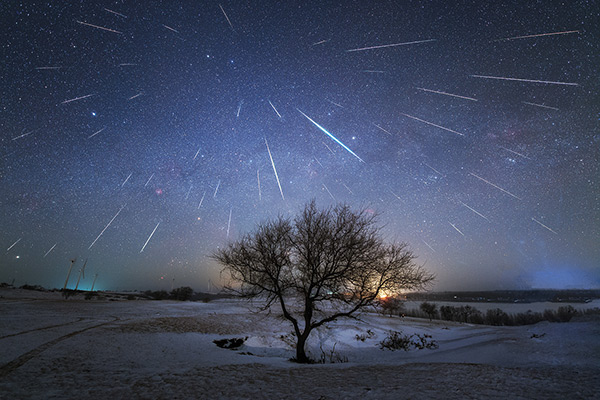Subtotal: $
Checkout-

A World Full of Signs
-

Covering the Cover: The Riddle of Nature
-

Back from Walden Pond
-

Can Masculinity Be Good?
-

Nature Is Obsessed with Me
-

Ancient Songs in the Desert
-

The Sadness of the Creatures
-

Meeting the Wolf
-

Saskatchewan, Promised Land
-

The Plants Can Talk
-

Saving the Soil, Saving the Farm
-

The Wonder of Moths
-

The Leper of Abercuawg
-

Dandelions: An Apology
-

A Wilderness God
-

Why I Hunt
-

Reading the Book of Nature
-

Breakwater
-

Lambing Season
-

Earthworks Urban Farm
-

Are You a Tree?
-

Practicing Christianity
-

Who Gets to Tell the Story?
-

A Medievalist Looks for the Image of Christ
-

In Defense of Chastity
-

Poem: “Let Them Grow”
-

Poem: “Squall”
-

Readers Respond
-

GEDs for Myanmar Migrants
-

Inside Nyansa Classical Community

Watching the Geminids
Sky-watchers have a chance to think about time differently.
By Maureen Swinger
May 4, 2024
Available languages: Deutsch
Next Article:
Explore Other Articles:
It’s 3:00 a.m. on a winter night, and my fifteen-year-old daughter and I are lying on our backs on the picnic table in our yard. It’s twenty degrees, but we have forgotten that we’re supposed to feel cold.
We are doing this because tonight is the peak of the Geminids, known to be the most prolific meteor shower of the year. We’re doing this because she is leaving home, and I’m not ready to part with her yet.
All right – she’ll only be gone for five months. She’s traveling to England as an exchange student; if I had that chance at fifteen, I’d want my mother to say, “Go! Go!” And I am – I am saying that. Cliffs of Dover, forests of bluebells, castles by the sea, streets Jane Austen walked. A boarding house under the eaves of a manor. Still, she won’t be here. We won’t have mother-daughter talks or walks or book chats or movie nights, and it doesn’t help that all the experienced empty-nesters are saying, “Five months are nothing!” It’s the beginning of the exodus. Don’t talk me out of my tears.

Dai Jianfang, Geminid Meteor Shower, 2021. Photograph from Wikimedia commons (public domain).
We started watching stars when she was a few weeks old, hardly six pounds, and, according to her dad, “nothing but eyes.” At age one, she would lie back against me in the Adirondack chair, way past bedtime on a June evening, and point first up at the still sky, and then over to the wood’s edge where the fireflies were anything but still. She didn’t make a sound; her eyes did all the talking. When she was two, and talking a mile a minute, she would still just gaze wordlessly upward at star-time; only once she said, quietly to herself, “God.”
I took my son out in winter, because he had croup and cold air is much easier to breathe. We’d sit in the same place in the yard, wrapped in layers of quilts, and he’d stab his chubby finger upward between barking coughs to inform me, “’Tar! ’Tar!” This would go on for some time, since he felt the need to identify each one.
For a while we forgot about these late-night escapades; daytime life got busier, and certainly by the time a surprise third child came along five years later, we were glad enough for everyone to fall into bed at the appointed hour, including ourselves.
It’s not as if life has now acquired a calm and stately pace. But as my eldest prepares for her first adventure without us, I think back often to my own childhood and the many gifts I was bestowed: my parents’ example, my grandmother’s quiet love, the strength of a believing community, and the lessons taught by one teacher in particular who showed us beauty in cloud patterns, bird migration, constellations. Almost all I know about the sky I learned from him.
Which is to say, I learned wonder. I don’t have a scientific mind, despite having attended lectures about gravitational pull, the time-space continuum, black holes, and other mysteries of the universe, inasmuch as anyone can explain them.

Rocky Raybell, Geminid Meteor from Keller, Washington, 2016. Photograph by Rocky Raybell / Flickr. Used by permission.
Instead of explaining, I’d rather go out at night with whoever can pry their eyes open, just to look up. It’s so very quiet in the predawn hours, and the stars are startlingly big and bright, as if they are closer to us than they were in the evening. Even one night in November when my eldest and I spent almost an hour waiting for some Leonids to make a faint appearance, we didn’t miss what didn’t come; the silence and the sense of the whole majestic universe turning above us made us both think, “God.”
And now, on the night of December 13, do the Geminids show up? They do! With over seventy-five meteors an hour flinging out from asteroid 3200 Phaethon, and a clear night with no moon, we watch in awe as the slashes of light appear, anywhere at all in the sky, falling, flying, underscoring constellations for split seconds, tangling in the black branches of the giant white oak.
We are quiet for a long time. Lines of a song come to mind – a verse from Marjorie Pickthall’s poem “Stars”:
And all the lonelier stars that have their place,
Calm lamps within the distant southern sky,
And planet-dust upon the edge of space,
Look down upon the fretful world, and I
Look up to outer vastness unafraid
And see the stars which sang when earth
was made.
These are the lights that we look to see now, the ones that watched when the foundations of the earth were laid, “while the morning stars sang together and all the angels shouted for joy” (Job 38:7).
I like to think that star-music will always connect this daughter and me, without the need for words. She’ll be watching the same night sky, only five hours earlier than me, for a little while. She’ll be back in time for the Perseids.
We drift indoors, and she goes back to bed, while my son emerges long enough to see three unmissable shooting stars; (’Tar!) there, he’s done it. But youngest daughter’s eyes pop open; she bursts out the back door to spend the next half hour pointing and shouting rapturously to me and the world at large: “There! Over there! Did you see it? It was so bright!” This gives way to reflections about where among the stars heaven is, and whether each star has an angel, and how fast they can travel between stars, and perhaps the shooting stars are angels.
Not content with peak night, she makes me promise to get her up again on the next night, and it is every bit as beautiful. I let her teachers know she might be tired and cranky, and she is. I’m sorry they have to pay for our nights of wonder. But not too sorry. After all, how often do these chances come around? While my first stargazing partner is away, I’m relieved and thankful to look upward with this eager child, toward “lonelier stars that have their place.”
Sky-watchers have a chance to think about time differently. You might decide on a whim to go out and see what the stars were doing four thousand light years ago. You might also want to know that every thirty-three years those often disappointing November Leonids blaze in a perfect storm of hundreds – even thousands – of meteors an hour. The next one is in 2033 and my youngest daughter and I have it on our calendar, even if the rest of the family is out in orbit. Wherever they are, I’m sure they’ll be looking up.
I trust my children to believe with Walt Whitman that “a leaf of grass is no less than the journey-work of the stars,” that a picnic table in a freezing winter yard is also a floating board in a spinning galaxy, that we too belong to the one who made everything else moving through space. I trust them to travel out with his guidance, like 3200 Phaethon, and circle back again every so often.
For a visual calendar of meteor showers, see meteorshowers.org.
Already a subscriber? Sign in
Try 3 months of unlimited access. Start your FREE TRIAL today. Cancel anytime.









































Bill Los
Thanks, Maureen, for the beautiful article! I too love the night sky and even though I have a telescope I still enjoy lying back and taking in the whole view with just my eyes. Having someone to share it with makes it even more special. As Henri Poincare once said: "Astronomy is useful because it shows how small our bodies, how large our minds". Blessings, Bill Los